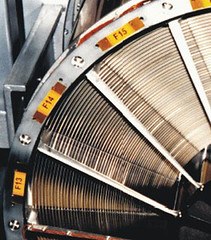
Look at the photo of the XMM-Newton X-ray mirror again and notice how many mirrors are nested inside each other. Each XMM-Newton mirror module used 58 nested mirrors. These are usually made in quadrants, so that each nested mirror is made in 4 parts (to make it easier to manufacture and easier to handle until the mirror is assemble). In addition, each mirror has two parts – a parabola and a hyperbola segment to focus the light onto the detector. That means that for each XMM telescope there were 58*4*2 = 464 mirror segments to make.
Suzaku used even more nested mirrors for each telescope: four of the telescopes used 175 nestings and one used 168 nestings. That means that each telescope used about 170*4*2 = 1,360 mirror segments. And there were five telescopes, so a total of about 6,800 mirror segments!
In order to make so many mirror segments quickly but accurately, engineers have developed a couple of processes. One is outlined in a clip from the Suzaku educational DVD (a small version is embedded to the right, but it can also be viewed at full resolution on the clip's page: Manufacturing the X-ray telescopes).
Another method involves glass “slumping.” The basic idea is that they start with a mandrel (a form) that is shaped just right for the mirror segment. On this mandrel, they put a flat piece of thin glass. Then they heat it up, and as they do, the glass will “slump” onto the mandrel, taking the shape of the mandrel. Once the glass cools, the engineers take it off the mandrel and apply a reflective coating. Once perfected, engineers can make the mirror shells by repeating this process with the proper mandrel sizes to make the different mirror shells.